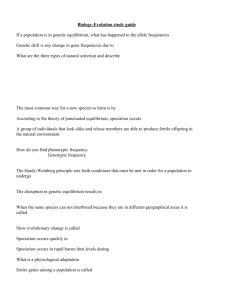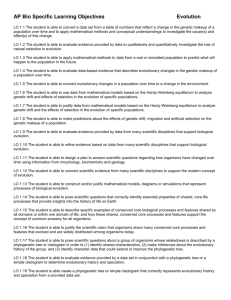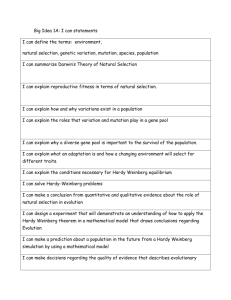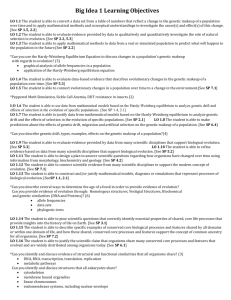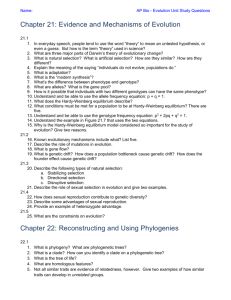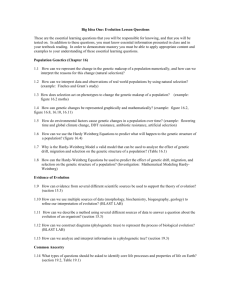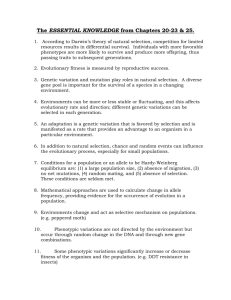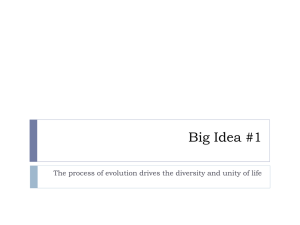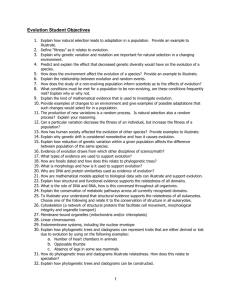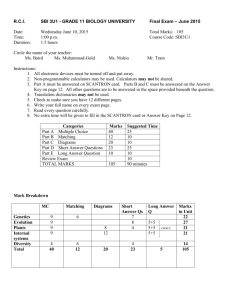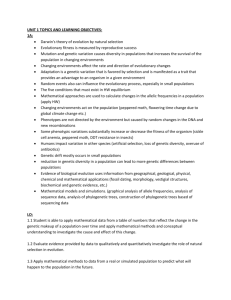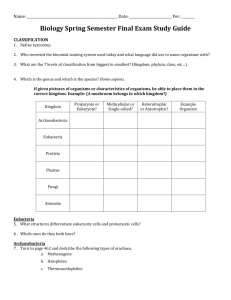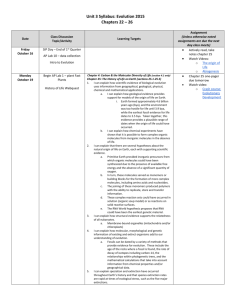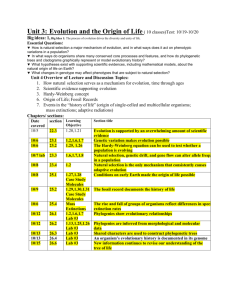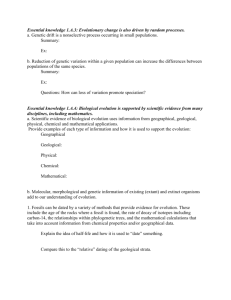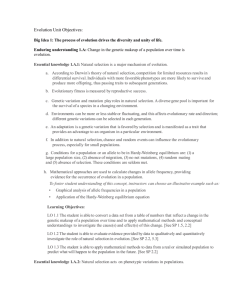APB Evolution Student Outline
advertisement
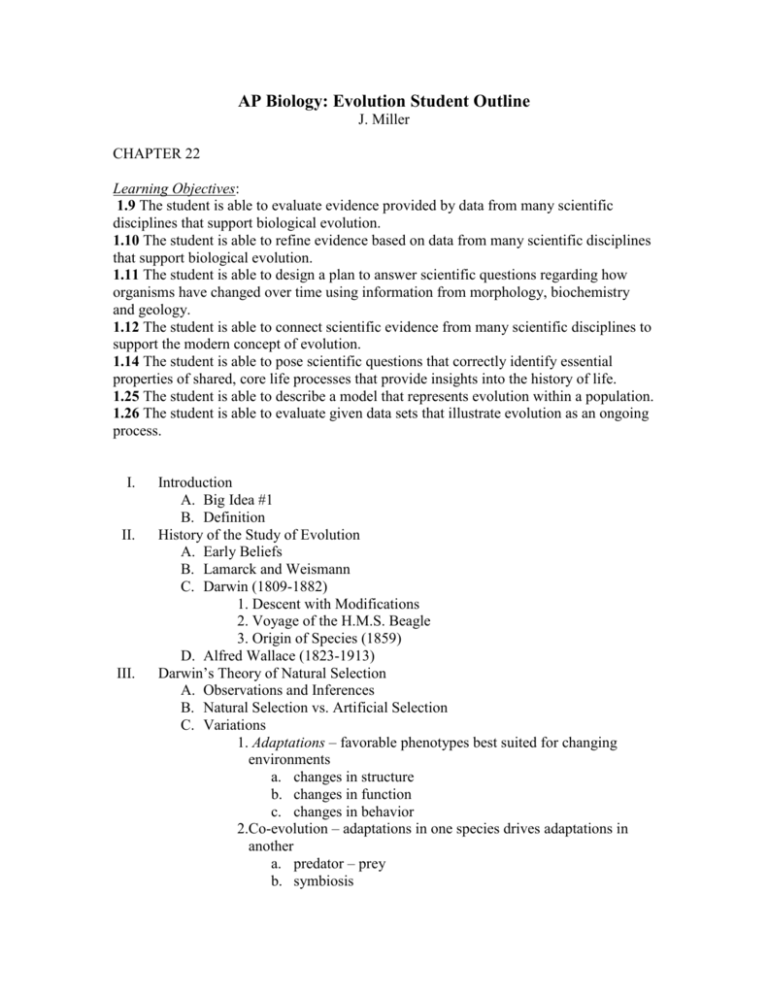
AP Biology: Evolution Student Outline J. Miller CHAPTER 22 Learning Objectives: 1.9 The student is able to evaluate evidence provided by data from many scientific disciplines that support biological evolution. 1.10 The student is able to refine evidence based on data from many scientific disciplines that support biological evolution. 1.11 The student is able to design a plan to answer scientific questions regarding how organisms have changed over time using information from morphology, biochemistry and geology. 1.12 The student is able to connect scientific evidence from many scientific disciplines to support the modern concept of evolution. 1.14 The student is able to pose scientific questions that correctly identify essential properties of shared, core life processes that provide insights into the history of life. 1.25 The student is able to describe a model that represents evolution within a population. 1.26 The student is able to evaluate given data sets that illustrate evolution as an ongoing process. I. II. III. Introduction A. Big Idea #1 B. Definition History of the Study of Evolution A. Early Beliefs B. Lamarck and Weismann C. Darwin (1809-1882) 1. Descent with Modifications 2. Voyage of the H.M.S. Beagle 3. Origin of Species (1859) D. Alfred Wallace (1823-1913) Darwin’s Theory of Natural Selection A. Observations and Inferences B. Natural Selection vs. Artificial Selection C. Variations 1. Adaptations – favorable phenotypes best suited for changing environments a. changes in structure b. changes in function c. changes in behavior 2.Co-evolution – adaptations in one species drives adaptations in another a. predator – prey b. symbiosis IV. i. commensalism ii. mutualism iii. parasitism iv. amensalism 3. Types of Adaptations a. camouflage b. warning coloration c. mimicry d. defense secretions e. bacterial resistance Evidence of Evolution A. Direct Observation B. Resistance C. Comparative Anatomy 1. Homology 2. Analogy a. Convergence b. Phylogeny 3. Vestigial Structures 4. Embryology D. Fossil Record E. Biogeography F. Physical Science G. Biochemical evidence H. Conservation of core elements CHAPTER 23 Learning Objectives: 1.1 The student is able to convert a data set from a table of numbers that reflect a change in the genetic makeup of a population over time and to apply mathematical methods and conceptual understanding to investigate the cause(s) and effect(s) of this change. 1.2 The student is able to evaluate evidence provided by data to qualitatively and quantitatively investigate the role of natural selection in evolution. 1.3 The student is able to apply mathematical methods to data from a real or simulated population to predict what will happen to the population in the future. 1.4 The student is able to evaluate data-based evidence that describes evolutionary changes in the genetic makeup of a population over time. 1.5 The student is able to connect evolutionary changes in a population over time to a change in the environment. 1.6 The student is able to use data from mathematical models based on the HardyWeinberg equilibrium to analyze genetic drift and effects of selection in the evolution of specific populations. 1.7 The student is able to justify data from mathematical models based on the HardyWeinberg equilibrium to analyze genetic drift and the effects of selection in the evolution of specific populations. 1.8 The student is able to make predictions about the effects of genetic drift, migration and artificial selection on the genetic makeup of a population. 4.26 The student is able to use theories and models to make scientific claims and/or predictions about the effects of variation within populations on survival and fitness. V. Population Evolution A. Variation 1. Genetic 2. Geographic B. Sources C. Hardy-Weinberg 1. Gene Pool 2. Conditions D. Natural Selection 1. Genetic Drift 2. Founder Effect 3. Bottleneck Effect 4. Gene flow E. Adaptive Evolution 1. Relative Fitness 2. Modes of Selection 3. Reproductive Selection 4. Heterozygote Advantage CHAPTER 24 Learning Objectives: 1.22 The student is able to use data from a real or simulated population(s), based on graphs or models of types of selection, to predict what will happen to the population in the future. 1.23 The student is able to justify the selection of data that address questions related to reproductive isolation and speciation. 1.24 The student is able to describe speciation in an isolated population and connect it to change in gene frequency, change in environment, natural selection and/or genetic drift. VI. Origin of Species A. Speciation B. Reproductive Isolation (barriers) C. Geographic Separation 1. Allopatric 2. Sympatric D. Polyploidy E. Hybrid Zones F. Rates of Speciation 1. Punctuated Equilibrium 2. Gradualism CHAPTER 25 Learning Objectives: 1.20 The student is able to analyze data related to questions of speciation and extinction throughout the Earth’s history. 1.21 The student is able to design a plan for collecting data to investigate the scientific claim that speciation and extinction have occurred throughout the Earth’s history. 1.27 The student is able to describe a scientific hypothesis about the origin of life on Earth. 1.28 The student is able to evaluate scientific questions based on hypotheses about the origin of life on Earth. 1.29 The student is able to describe the reasons for revisions of scientific hypothesis of the origin of life on Earth. 1.30 The student is able to evaluate scientific hypotheses about the origin of life on Earth. 1.31 The student is able to evaluate the accuracy and legitimacy of data to answer scientific questions about the origin of life on Earth. 1.32 The student is able to justify the selection of geological, physical, and chemical data that reveal early Earth conditions. VII. History of Life on Earth A. Origin of Life 1. Oparin 2. Miller-Urey 3. RNA World Hypothesis 4.Protocells B. Endosymbiosis C. Fossil Record D. Radiometric and Relative Dating E. Mass Extinctions F. Adaptive Radiation CHAPTER 26 Learning Objectives: 1.13 The student is able to construct and/or justify mathematical models, diagrams or simulations that represent processes of biological evolution. 1.15 The student is able to describe specific examples of conserved core biological processes and features shared by all domains or within one domain of life, and how these shared, conserved core processes and features support the concept of common ancestry for all organisms. 1.16 The student is able to justify the scientific claim that organisms share many conserved core processes and features that evolved and are widely distributed among organisms today. 1.17 The student is able to pose scientific questions about a group of organisms whose relatedness is described by a phylogenetic tree or cladogram in order to (1) identify shared characteristics, (2) make inferences about the evolutionary history of the group, and (3) identify character data that could extend or improve the phylogenetic tree. 1.18 The student is able to evaluate evidence provided by a data set in conjunction with a phylogenetic tree or simple cladogram to determine evolutionary history and speciation. 1.19 The student is able to create a phylogenetic tree or simple cladogram that correctly represents evolutionary history and speciation from a provided data set. 2.25 The student can construct explanations based on scientific evidence that homeostatic mechanisms reflect continuity due to common ancestry and/or divergence due to adaptation in different environments. 2.26 The student is able to analyze data to identify phylogenetic patterns or relationships, showing that homeostatic mechanisms reflect both continuity due to common ancestry and change due to evolution in different environments. VIII. Phylogeny A. Classifications B. Cladistics

